MNG00724 HRM Report: Recruitment of Top Talent Women in Leadership
VerifiedAdded on 2022/12/26
|13
|3088
|62
Report
AI Summary
This report delves into the complexities of gender analysis and imbalances within senior roles in organizations, particularly in a multinational context. It examines the recruitment and selection processes, highlighting the challenges faced by women in obtaining top positions. The report explores external recruitment strategies, selection processes, and common biases such as affinity bias and gender bias. It also analyzes the roles of senior leadership, line managers, and HRM in the recruitment process, offering recommendations for more equitable practices. The conclusion emphasizes the importance of addressing gender discrimination and promoting equal opportunities for women in leadership, connecting these organizational changes to broader societal and global movements. The report underscores the critical role of HRM in fostering a skilled, innovative, and creative workforce by improving the recruitment and selection of talented women.
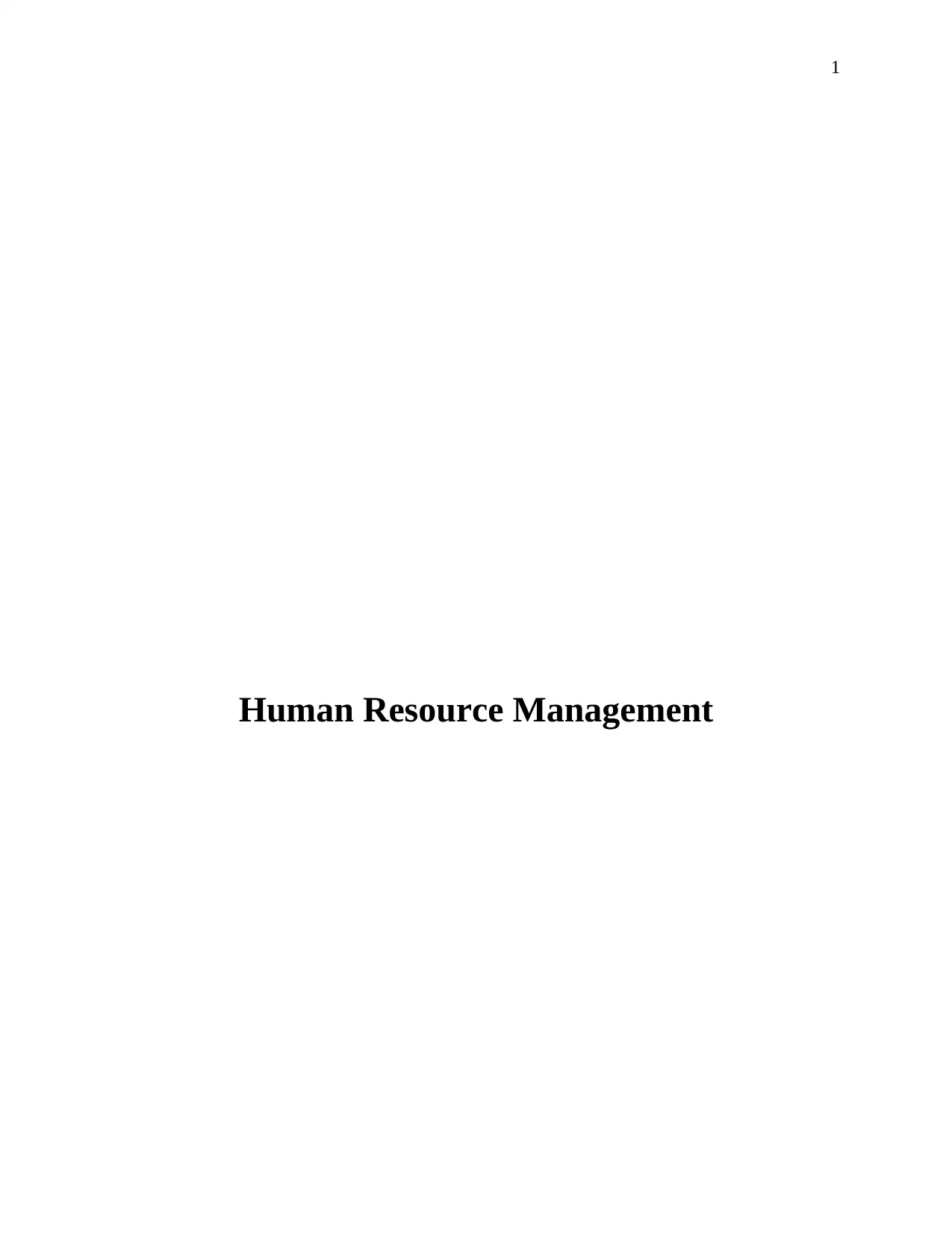
1
Human Resource Management
Human Resource Management
Paraphrase This Document
Need a fresh take? Get an instant paraphrase of this document with our AI Paraphraser
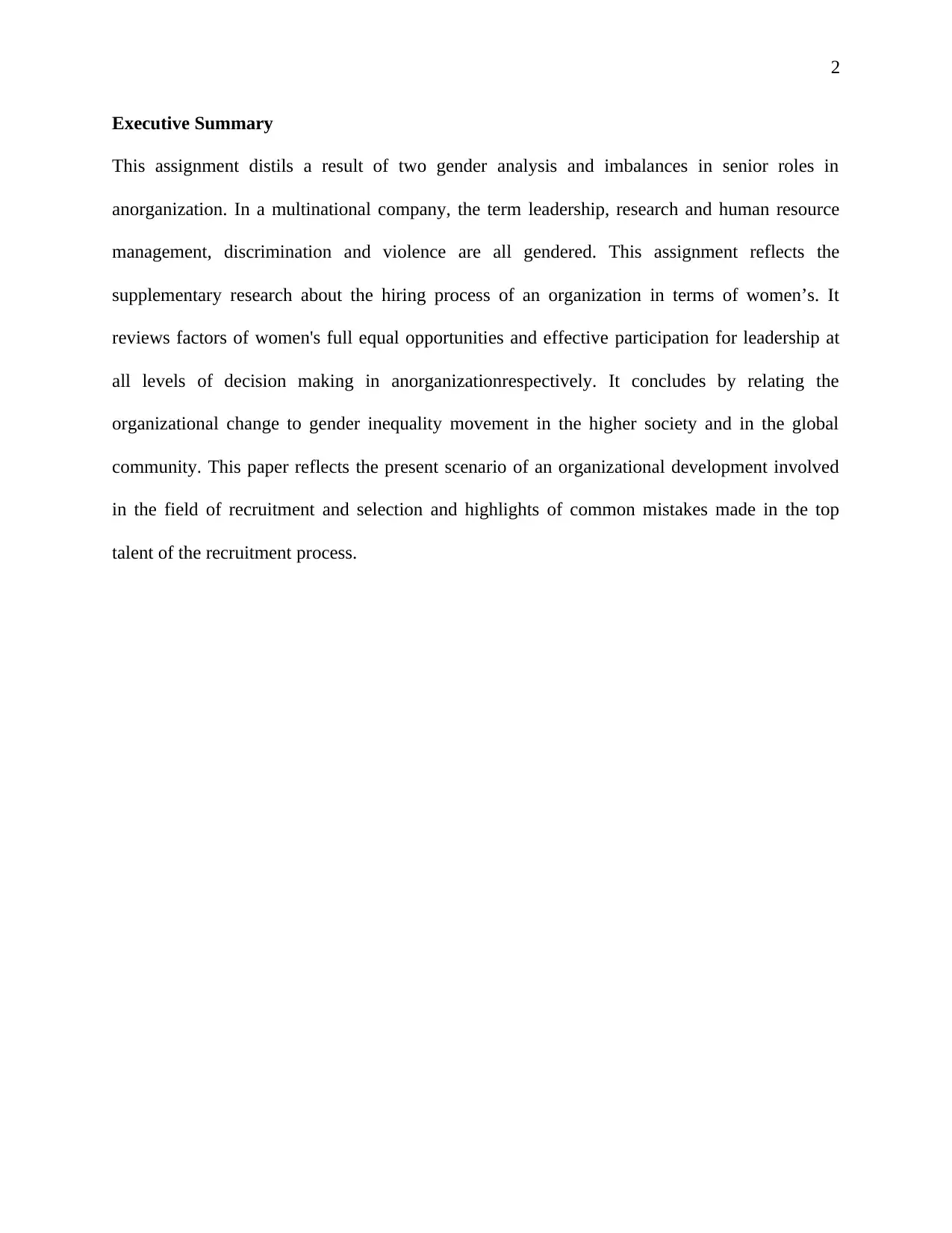
2
Executive Summary
This assignment distils a result of two gender analysis and imbalances in senior roles in
anorganization. In a multinational company, the term leadership, research and human resource
management, discrimination and violence are all gendered. This assignment reflects the
supplementary research about the hiring process of an organization in terms of women’s. It
reviews factors of women's full equal opportunities and effective participation for leadership at
all levels of decision making in anorganizationrespectively. It concludes by relating the
organizational change to gender inequality movement in the higher society and in the global
community. This paper reflects the present scenario of an organizational development involved
in the field of recruitment and selection and highlights of common mistakes made in the top
talent of the recruitment process.
Executive Summary
This assignment distils a result of two gender analysis and imbalances in senior roles in
anorganization. In a multinational company, the term leadership, research and human resource
management, discrimination and violence are all gendered. This assignment reflects the
supplementary research about the hiring process of an organization in terms of women’s. It
reviews factors of women's full equal opportunities and effective participation for leadership at
all levels of decision making in anorganizationrespectively. It concludes by relating the
organizational change to gender inequality movement in the higher society and in the global
community. This paper reflects the present scenario of an organizational development involved
in the field of recruitment and selection and highlights of common mistakes made in the top
talent of the recruitment process.

3
Table of Contents
Introduction......................................................................................................................................4
Overview of External Recruitment and Selection Process, especially for top women...................4
Selection Process for Top Women:.................................................................................................5
Discussion of common mistakes made in the recruitment of top talent women’s..........................6
Analysis of the role of the Senior Leadership, Line Managers, and HRM in the Recruitment and
the Selection process (especially for women).................................................................................8
Recommendations on Recruiting and Selecting of top women.......................................................9
Conclusion.....................................................................................................................................10
References List..............................................................................................................................11
Table of Contents
Introduction......................................................................................................................................4
Overview of External Recruitment and Selection Process, especially for top women...................4
Selection Process for Top Women:.................................................................................................5
Discussion of common mistakes made in the recruitment of top talent women’s..........................6
Analysis of the role of the Senior Leadership, Line Managers, and HRM in the Recruitment and
the Selection process (especially for women).................................................................................8
Recommendations on Recruiting and Selecting of top women.......................................................9
Conclusion.....................................................................................................................................10
References List..............................................................................................................................11
⊘ This is a preview!⊘
Do you want full access?
Subscribe today to unlock all pages.

Trusted by 1+ million students worldwide

4
Introduction
The term Human Resource is considered one of the most important factors of an organizational
structure. It serves as a functional backbone in an organization. The success of every company
depends upon the skilled, innovative and the creative labour force. As all organization likely to
get skilled and innovative labour force the employee recruitment and selection is very crucial to
every organization.The hiring for top and talented women in the superior position of an
organization results in failure of gender-neutral language in the job ads. In many organization,
men have occupied the senior's management position which results in gender inequality and
severe inconvenience for women's to get recruited or hired. The process of recruiting talented
women faces several issues like single person interview, fails to check reports and references.
Many top and skilled women do not want to work in the top position as it faces sexual
harassment, gender discrimination, different recruitment structures for themandprejudice of
women illegitimacy.
Overview of External Recruitment and Selection Process, especially for top women
The term external recruitment means hiring people from outside the organization. The concept of
external recruitment generally takes place in the form of advertisement like ads in the
newspapers, employee referrals, telecasting and many more (Nielsen 2015, p.390). It fails to use
gender-neutral language in the job advertisement. There are some advantages relating to external
recruitment like a bigger pool of candidates and the chance of getting new skills whereas it
suffers from certain disadvantage like time-consuming and costly. The method of external
recruitment generally includes online recruitment, job boards, social media, job fairs, events and
recruitment agencies.In many multinational companies, the recruitment and the selection process
goes viral for top and talented women. There are very common issues that prevail in an
Introduction
The term Human Resource is considered one of the most important factors of an organizational
structure. It serves as a functional backbone in an organization. The success of every company
depends upon the skilled, innovative and the creative labour force. As all organization likely to
get skilled and innovative labour force the employee recruitment and selection is very crucial to
every organization.The hiring for top and talented women in the superior position of an
organization results in failure of gender-neutral language in the job ads. In many organization,
men have occupied the senior's management position which results in gender inequality and
severe inconvenience for women's to get recruited or hired. The process of recruiting talented
women faces several issues like single person interview, fails to check reports and references.
Many top and skilled women do not want to work in the top position as it faces sexual
harassment, gender discrimination, different recruitment structures for themandprejudice of
women illegitimacy.
Overview of External Recruitment and Selection Process, especially for top women
The term external recruitment means hiring people from outside the organization. The concept of
external recruitment generally takes place in the form of advertisement like ads in the
newspapers, employee referrals, telecasting and many more (Nielsen 2015, p.390). It fails to use
gender-neutral language in the job advertisement. There are some advantages relating to external
recruitment like a bigger pool of candidates and the chance of getting new skills whereas it
suffers from certain disadvantage like time-consuming and costly. The method of external
recruitment generally includes online recruitment, job boards, social media, job fairs, events and
recruitment agencies.In many multinational companies, the recruitment and the selection process
goes viral for top and talented women. There are very common issues that prevail in an
Paraphrase This Document
Need a fresh take? Get an instant paraphrase of this document with our AI Paraphraser

5
organization for talented women's like men's vs women's issue, gender bias, sexual harassment,
work-life imbalance, maternity leaves, lack of role models, ego clashes and an unsupportive
appearance (Tafti, Mahmoudsaleh andAmiri 2017, p.18).
Selection Process for Top Women:
1. Preliminary Interview: This stage is for the basic interview of womenfor superior posts; so as
to eliminate them who are not that much good from appearance and physique.
2. Receiving Applications:Many tops and the talented women's apply for the job by sending
resumes applications to the organization. The application gives basic information to the
candidate about the past record and work experience for the suitable post (Mann, 2018, p.85).
3. Screening of Applications:After receiving the resumes applications; special screening for top
and talented women’s are performed. It depicts the qualification, appearance, physique and body
language.
4. Employment Tests:In this stage, the organization asks the women’s for their talent and skills in
a particular field. This can be done through several employment tests, personality tests and
proficiency tests (Stone and Deadrick 2015, p.144). This stage excludes women’s
distributionchanneland organizational benefits.
organization for talented women's like men's vs women's issue, gender bias, sexual harassment,
work-life imbalance, maternity leaves, lack of role models, ego clashes and an unsupportive
appearance (Tafti, Mahmoudsaleh andAmiri 2017, p.18).
Selection Process for Top Women:
1. Preliminary Interview: This stage is for the basic interview of womenfor superior posts; so as
to eliminate them who are not that much good from appearance and physique.
2. Receiving Applications:Many tops and the talented women's apply for the job by sending
resumes applications to the organization. The application gives basic information to the
candidate about the past record and work experience for the suitable post (Mann, 2018, p.85).
3. Screening of Applications:After receiving the resumes applications; special screening for top
and talented women’s are performed. It depicts the qualification, appearance, physique and body
language.
4. Employment Tests:In this stage, the organization asks the women’s for their talent and skills in
a particular field. This can be done through several employment tests, personality tests and
proficiency tests (Stone and Deadrick 2015, p.144). This stage excludes women’s
distributionchanneland organizational benefits.
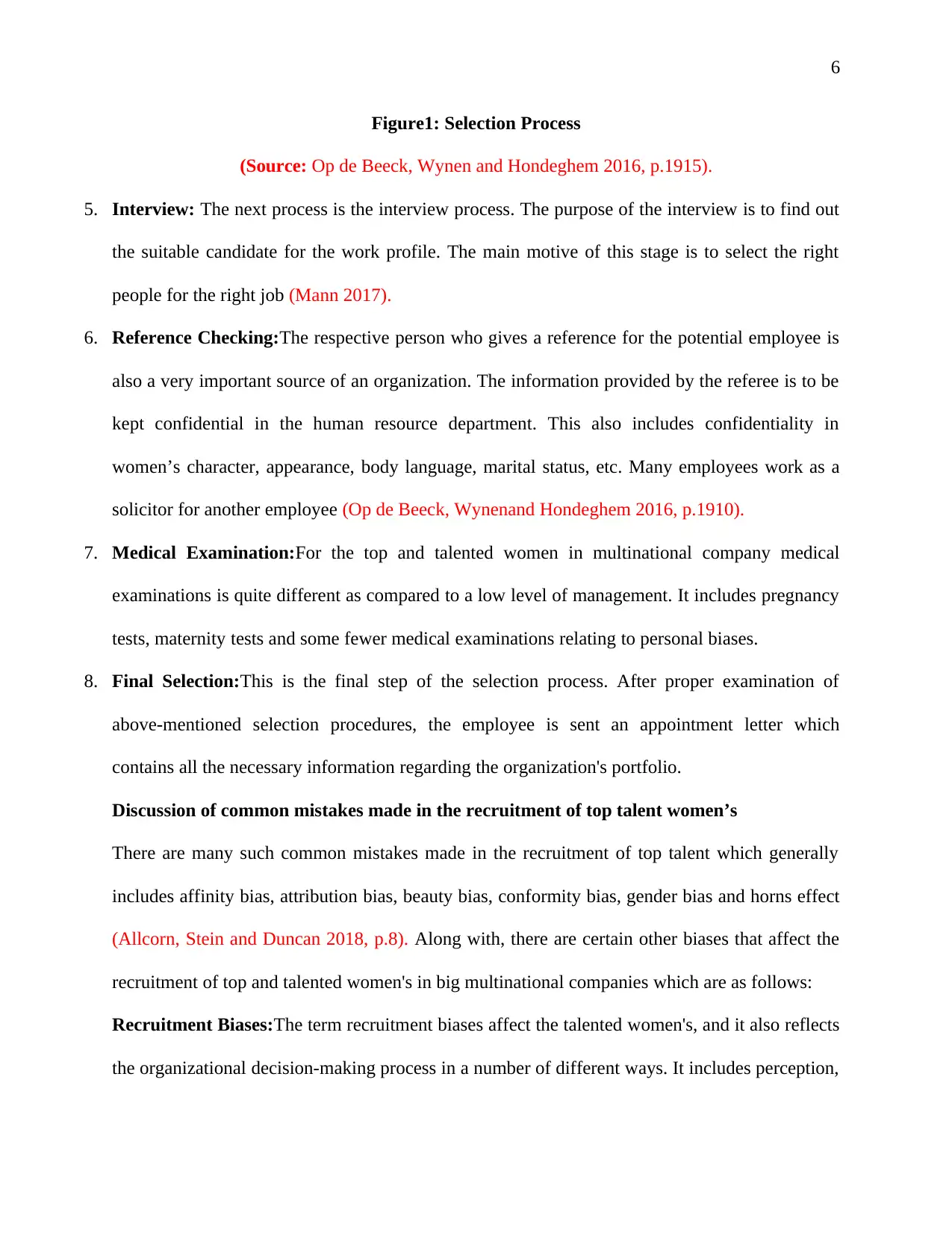
6
Figure1: Selection Process
(Source: Op de Beeck, Wynen and Hondeghem 2016, p.1915).
5. Interview: The next process is the interview process. The purpose of the interview is to find out
the suitable candidate for the work profile. The main motive of this stage is to select the right
people for the right job (Mann 2017).
6. Reference Checking:The respective person who gives a reference for the potential employee is
also a very important source of an organization. The information provided by the referee is to be
kept confidential in the human resource department. This also includes confidentiality in
women’s character, appearance, body language, marital status, etc. Many employees work as a
solicitor for another employee (Op de Beeck, Wynenand Hondeghem 2016, p.1910).
7. Medical Examination:For the top and talented women in multinational company medical
examinations is quite different as compared to a low level of management. It includes pregnancy
tests, maternity tests and some fewer medical examinations relating to personal biases.
8. Final Selection:This is the final step of the selection process. After proper examination of
above-mentioned selection procedures, the employee is sent an appointment letter which
contains all the necessary information regarding the organization's portfolio.
Discussion of common mistakes made in the recruitment of top talent women’s
There are many such common mistakes made in the recruitment of top talent which generally
includes affinity bias, attribution bias, beauty bias, conformity bias, gender bias and horns effect
(Allcorn, Stein and Duncan 2018, p.8). Along with, there are certain other biases that affect the
recruitment of top and talented women's in big multinational companies which are as follows:
Recruitment Biases:The term recruitment biases affect the talented women's, and it also reflects
the organizational decision-making process in a number of different ways. It includes perception,
Figure1: Selection Process
(Source: Op de Beeck, Wynen and Hondeghem 2016, p.1915).
5. Interview: The next process is the interview process. The purpose of the interview is to find out
the suitable candidate for the work profile. The main motive of this stage is to select the right
people for the right job (Mann 2017).
6. Reference Checking:The respective person who gives a reference for the potential employee is
also a very important source of an organization. The information provided by the referee is to be
kept confidential in the human resource department. This also includes confidentiality in
women’s character, appearance, body language, marital status, etc. Many employees work as a
solicitor for another employee (Op de Beeck, Wynenand Hondeghem 2016, p.1910).
7. Medical Examination:For the top and talented women in multinational company medical
examinations is quite different as compared to a low level of management. It includes pregnancy
tests, maternity tests and some fewer medical examinations relating to personal biases.
8. Final Selection:This is the final step of the selection process. After proper examination of
above-mentioned selection procedures, the employee is sent an appointment letter which
contains all the necessary information regarding the organization's portfolio.
Discussion of common mistakes made in the recruitment of top talent women’s
There are many such common mistakes made in the recruitment of top talent which generally
includes affinity bias, attribution bias, beauty bias, conformity bias, gender bias and horns effect
(Allcorn, Stein and Duncan 2018, p.8). Along with, there are certain other biases that affect the
recruitment of top and talented women's in big multinational companies which are as follows:
Recruitment Biases:The term recruitment biases affect the talented women's, and it also reflects
the organizational decision-making process in a number of different ways. It includes perception,
⊘ This is a preview!⊘
Do you want full access?
Subscribe today to unlock all pages.

Trusted by 1+ million students worldwide

7
attitude, behaviours, listening skills, and attention and micro-affirmations. The most common
biases in a recruitment process which affects the top and talented women’s are conformity biases
and beauty biases (Rai 2017).This is in the view that the most beautiful women will work more
successfully. It mostly focuses on attractive women's who will work for their organization at a
topmost level as a superior. It works as a horn effect like if any negativity lies in a woman's
character by interviewing; the recruiter hence ignores that spore and judge them as an intelligent
woman as she is an attraction for that vacant position (Nielsen 2015, p.395). Whereas, it can also
be seen that at a topmost level, mostly male candidates capture the place and crafts an infirmity
for women's post by minimizing the other organizational benefits and etc. This results in
women's gender discrimination.
Organization Culture Assumptions:The organizational culture assumptions are based on the
judgments, belief system and thinking. It works as an invisible, taken from granted values and
beliefs that form the culture of an organization. In a large multinational company, it depicts the
underlying values of interacting that contribute to the psychological and social environment of an
organization (Lawrence, Lonsdale and Le Mesurier 2018, p.308). For recruiting top and talented
women’s for the top level,theassumptions influence how much women identifythemselves within
their organization. Usually, the organization culture assumptions are not easily found, neither
discussed nor written. They are generally comprised of unconscious perceptions, beliefs, feelings
and thoughts of an employee (Auster and Prasad 2016, p.180).
Selection Methods: The selection methods of top and talented women's comprises of various
common mistakes which adhere to the recruitment process of an organization. Oftentimes, there
is no consensus among the evaluators on the specific skills, and there is insufficient information
regarding the job postings. The recruitment process takes too long. This results in many talented
attitude, behaviours, listening skills, and attention and micro-affirmations. The most common
biases in a recruitment process which affects the top and talented women’s are conformity biases
and beauty biases (Rai 2017).This is in the view that the most beautiful women will work more
successfully. It mostly focuses on attractive women's who will work for their organization at a
topmost level as a superior. It works as a horn effect like if any negativity lies in a woman's
character by interviewing; the recruiter hence ignores that spore and judge them as an intelligent
woman as she is an attraction for that vacant position (Nielsen 2015, p.395). Whereas, it can also
be seen that at a topmost level, mostly male candidates capture the place and crafts an infirmity
for women's post by minimizing the other organizational benefits and etc. This results in
women's gender discrimination.
Organization Culture Assumptions:The organizational culture assumptions are based on the
judgments, belief system and thinking. It works as an invisible, taken from granted values and
beliefs that form the culture of an organization. In a large multinational company, it depicts the
underlying values of interacting that contribute to the psychological and social environment of an
organization (Lawrence, Lonsdale and Le Mesurier 2018, p.308). For recruiting top and talented
women’s for the top level,theassumptions influence how much women identifythemselves within
their organization. Usually, the organization culture assumptions are not easily found, neither
discussed nor written. They are generally comprised of unconscious perceptions, beliefs, feelings
and thoughts of an employee (Auster and Prasad 2016, p.180).
Selection Methods: The selection methods of top and talented women's comprises of various
common mistakes which adhere to the recruitment process of an organization. Oftentimes, there
is no consensus among the evaluators on the specific skills, and there is insufficient information
regarding the job postings. The recruitment process takes too long. This results in many talented
Paraphrase This Document
Need a fresh take? Get an instant paraphrase of this document with our AI Paraphraser
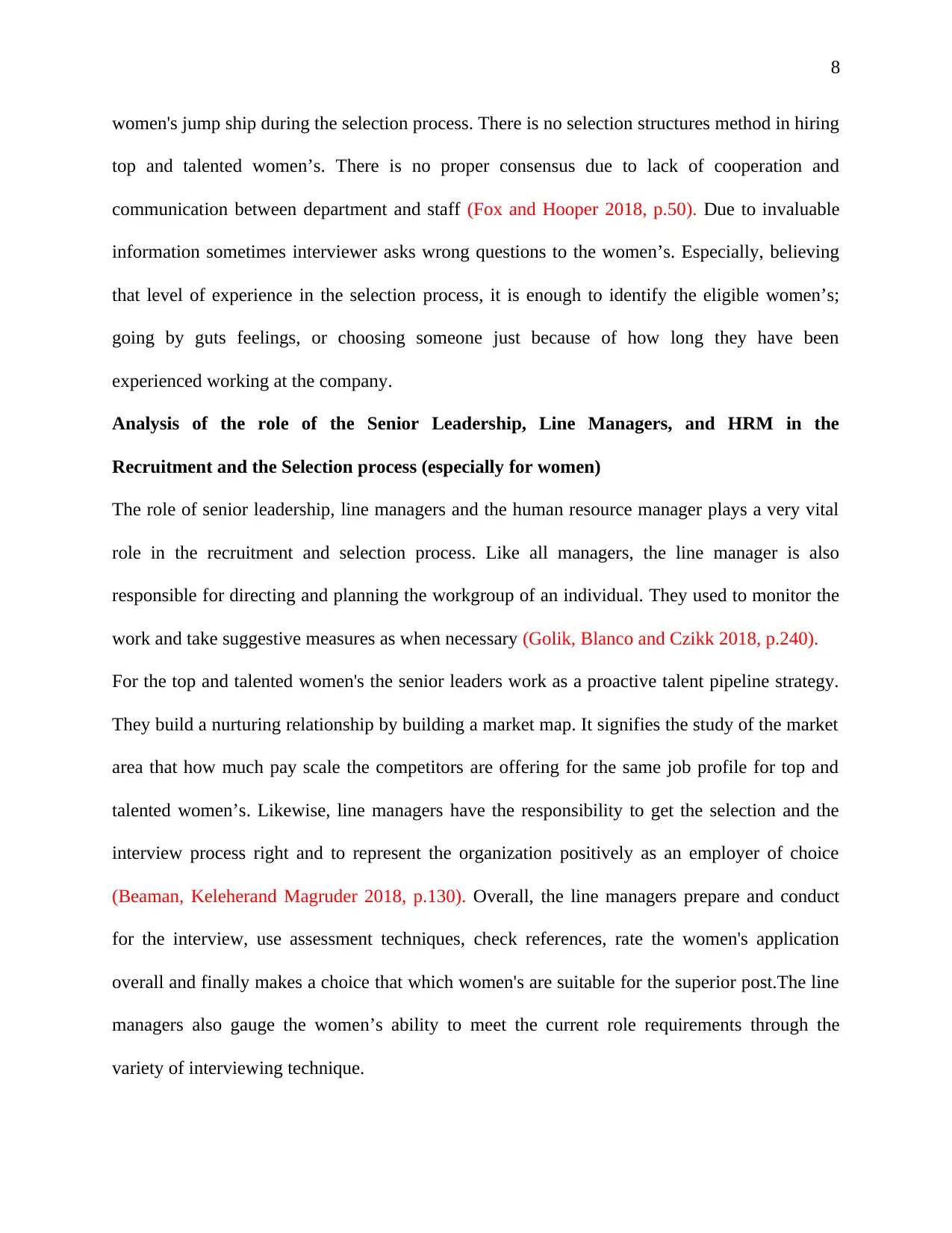
8
women's jump ship during the selection process. There is no selection structures method in hiring
top and talented women’s. There is no proper consensus due to lack of cooperation and
communication between department and staff (Fox and Hooper 2018, p.50). Due to invaluable
information sometimes interviewer asks wrong questions to the women’s. Especially, believing
that level of experience in the selection process, it is enough to identify the eligible women’s;
going by guts feelings, or choosing someone just because of how long they have been
experienced working at the company.
Analysis of the role of the Senior Leadership, Line Managers, and HRM in the
Recruitment and the Selection process (especially for women)
The role of senior leadership, line managers and the human resource manager plays a very vital
role in the recruitment and selection process. Like all managers, the line manager is also
responsible for directing and planning the workgroup of an individual. They used to monitor the
work and take suggestive measures as when necessary (Golik, Blanco and Czikk 2018, p.240).
For the top and talented women's the senior leaders work as a proactive talent pipeline strategy.
They build a nurturing relationship by building a market map. It signifies the study of the market
area that how much pay scale the competitors are offering for the same job profile for top and
talented women’s. Likewise, line managers have the responsibility to get the selection and the
interview process right and to represent the organization positively as an employer of choice
(Beaman, Keleherand Magruder 2018, p.130). Overall, the line managers prepare and conduct
for the interview, use assessment techniques, check references, rate the women's application
overall and finally makes a choice that which women's are suitable for the superior post.The line
managers also gauge the women’s ability to meet the current role requirements through the
variety of interviewing technique.
women's jump ship during the selection process. There is no selection structures method in hiring
top and talented women’s. There is no proper consensus due to lack of cooperation and
communication between department and staff (Fox and Hooper 2018, p.50). Due to invaluable
information sometimes interviewer asks wrong questions to the women’s. Especially, believing
that level of experience in the selection process, it is enough to identify the eligible women’s;
going by guts feelings, or choosing someone just because of how long they have been
experienced working at the company.
Analysis of the role of the Senior Leadership, Line Managers, and HRM in the
Recruitment and the Selection process (especially for women)
The role of senior leadership, line managers and the human resource manager plays a very vital
role in the recruitment and selection process. Like all managers, the line manager is also
responsible for directing and planning the workgroup of an individual. They used to monitor the
work and take suggestive measures as when necessary (Golik, Blanco and Czikk 2018, p.240).
For the top and talented women's the senior leaders work as a proactive talent pipeline strategy.
They build a nurturing relationship by building a market map. It signifies the study of the market
area that how much pay scale the competitors are offering for the same job profile for top and
talented women’s. Likewise, line managers have the responsibility to get the selection and the
interview process right and to represent the organization positively as an employer of choice
(Beaman, Keleherand Magruder 2018, p.130). Overall, the line managers prepare and conduct
for the interview, use assessment techniques, check references, rate the women's application
overall and finally makes a choice that which women's are suitable for the superior post.The line
managers also gauge the women’s ability to meet the current role requirements through the
variety of interviewing technique.
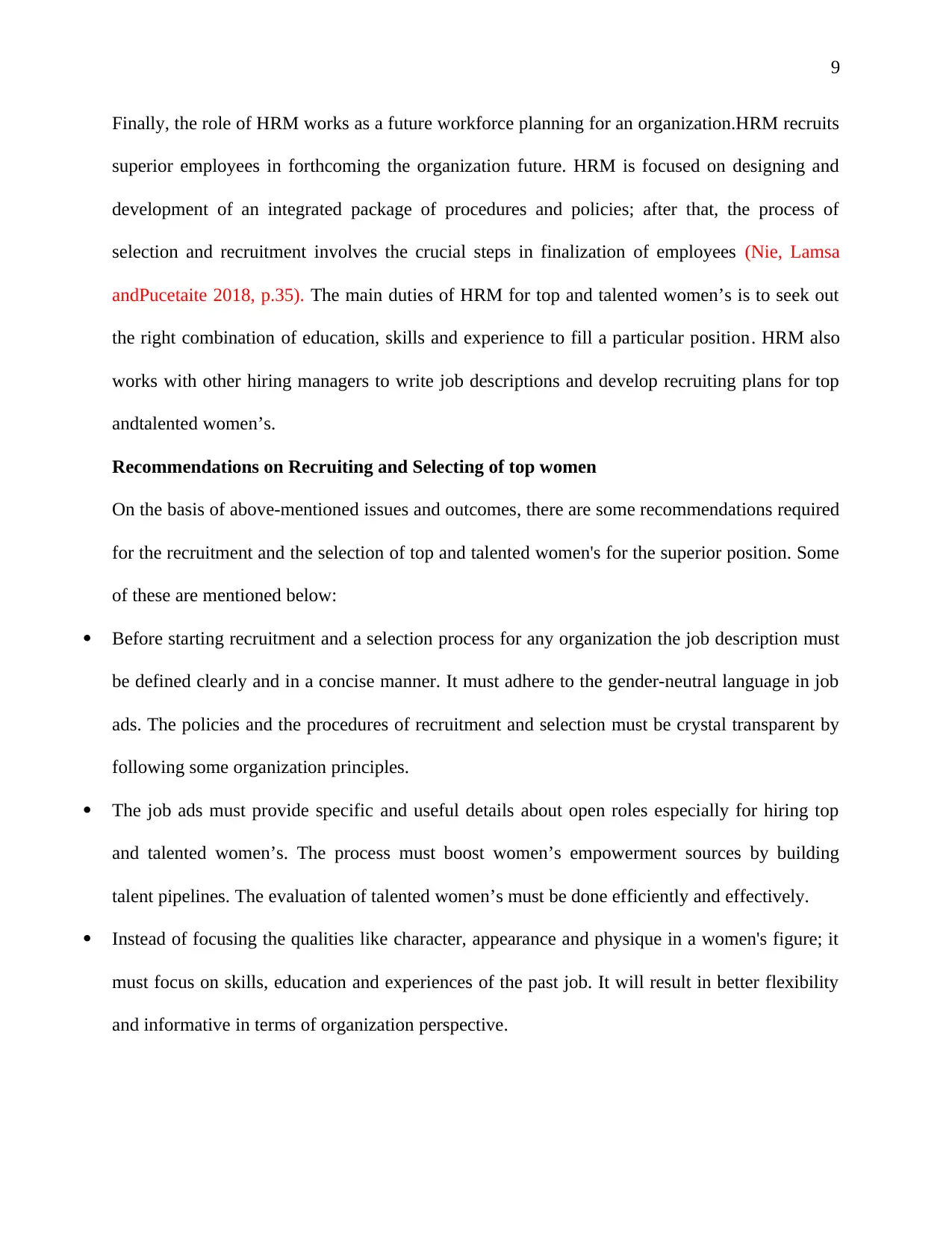
9
Finally, the role of HRM works as a future workforce planning for an organization.HRM recruits
superior employees in forthcoming the organization future. HRM is focused on designing and
development of an integrated package of procedures and policies; after that, the process of
selection and recruitment involves the crucial steps in finalization of employees (Nie, Lamsa
andPucetaite 2018, p.35). The main duties of HRM for top and talented women’s is to seek out
the right combination of education, skills and experience to fill a particular position. HRM also
works with other hiring managers to write job descriptions and develop recruiting plans for top
andtalented women’s.
Recommendations on Recruiting and Selecting of top women
On the basis of above-mentioned issues and outcomes, there are some recommendations required
for the recruitment and the selection of top and talented women's for the superior position. Some
of these are mentioned below:
Before starting recruitment and a selection process for any organization the job description must
be defined clearly and in a concise manner. It must adhere to the gender-neutral language in job
ads. The policies and the procedures of recruitment and selection must be crystal transparent by
following some organization principles.
The job ads must provide specific and useful details about open roles especially for hiring top
and talented women’s. The process must boost women’s empowerment sources by building
talent pipelines. The evaluation of talented women’s must be done efficiently and effectively.
Instead of focusing the qualities like character, appearance and physique in a women's figure; it
must focus on skills, education and experiences of the past job. It will result in better flexibility
and informative in terms of organization perspective.
Finally, the role of HRM works as a future workforce planning for an organization.HRM recruits
superior employees in forthcoming the organization future. HRM is focused on designing and
development of an integrated package of procedures and policies; after that, the process of
selection and recruitment involves the crucial steps in finalization of employees (Nie, Lamsa
andPucetaite 2018, p.35). The main duties of HRM for top and talented women’s is to seek out
the right combination of education, skills and experience to fill a particular position. HRM also
works with other hiring managers to write job descriptions and develop recruiting plans for top
andtalented women’s.
Recommendations on Recruiting and Selecting of top women
On the basis of above-mentioned issues and outcomes, there are some recommendations required
for the recruitment and the selection of top and talented women's for the superior position. Some
of these are mentioned below:
Before starting recruitment and a selection process for any organization the job description must
be defined clearly and in a concise manner. It must adhere to the gender-neutral language in job
ads. The policies and the procedures of recruitment and selection must be crystal transparent by
following some organization principles.
The job ads must provide specific and useful details about open roles especially for hiring top
and talented women’s. The process must boost women’s empowerment sources by building
talent pipelines. The evaluation of talented women’s must be done efficiently and effectively.
Instead of focusing the qualities like character, appearance and physique in a women's figure; it
must focus on skills, education and experiences of the past job. It will result in better flexibility
and informative in terms of organization perspective.
⊘ This is a preview!⊘
Do you want full access?
Subscribe today to unlock all pages.

Trusted by 1+ million students worldwide

10
From the above study, it can be assumed that in the superior post mostly male candidates are
present for hiring which results in top and talented women's to face certain sexual harassment
preachment and gender discrimination. This must be changed immediately to avoid the
impairment in an organization.
Conclusion
From the above study, it can be concluded that the recruitment and the selection process in big
multinational companies suffer from severe demerits which led top and talented women's to face
certain difficulties like gender discrimination, sexual harassment and etc. The term recruitment
and selection processare considered one of the most important partsof an organizational
structure. However, it faces certain disruptions and demerits for the particular superior posts.
This assignment mainly reflects the recruitment and selection procedures, especially for top and
talented women, are who seeks for the superior post, and later it led them to face certain
difficulties in an organization. This paper also provides some recommendations based on some
prevailing issues which many organizations must overcome to impoverish the recruitment and
selection process.
From the above study, it can be assumed that in the superior post mostly male candidates are
present for hiring which results in top and talented women's to face certain sexual harassment
preachment and gender discrimination. This must be changed immediately to avoid the
impairment in an organization.
Conclusion
From the above study, it can be concluded that the recruitment and the selection process in big
multinational companies suffer from severe demerits which led top and talented women's to face
certain difficulties like gender discrimination, sexual harassment and etc. The term recruitment
and selection processare considered one of the most important partsof an organizational
structure. However, it faces certain disruptions and demerits for the particular superior posts.
This assignment mainly reflects the recruitment and selection procedures, especially for top and
talented women, are who seeks for the superior post, and later it led them to face certain
difficulties in an organization. This paper also provides some recommendations based on some
prevailing issues which many organizations must overcome to impoverish the recruitment and
selection process.
Paraphrase This Document
Need a fresh take? Get an instant paraphrase of this document with our AI Paraphraser

11
References List
Allcorn, S., Stein, H.F. & Duncan, C.M., 2018,‘The Fallacy of Selecting the Right Person for the
Job’, International Journal of Leadership and Change, Vol 6, no. 1, p.8. Available at:
https://digitalcommons.wku.edu/ijlc/vol6/iss1/8/ [Viewed 3rd May, 2019]
Auster, E.R. & Prasad, A, 2016,‘Why do women still not make it to the top? Dominant
organizational ideologies and biases by promotion committees limit opportunities to destination
positions’, Sex Roles, Vol7, no. 5-6, pp.177-196. Available at:
https://link.springer.com/article/10.1007/s11199-016-0607-0[Viewed 3rd May, 2019]
Beaman, L., Keleher, N & Magruder, J., 2018,‘Do job networks, disadvantage women? Evidence
from a recruitment experiment in Malawi’, Journal of Labor Economics, Vol 36, no. 1, pp.121-
157. Available at: https://www.journals.uchicago.edu/doi/abs/10.1086/693869[Viewed 3rd May,
2019]
Fox, C. & Hooper, N., 2018,‘How to make your board smarter’, Company Director, Vol 34, no.
2, p.50. Available at:
https://search.informit.com.au/documentSummary;dn=114654376968291;res=IELAPA[Viewed
3rd May, 2019]
Golik, M.N., Blanco, M.R. &Czikk, R., 2018,‘On the trail of line managers as talent
spotters’,Human Resource Development International, Vol 21, no. 3, pp.232-253. Available at:
https://www.tandfonline.com/doi/abs/10.1080/13678868.2017.1385195[Viewed 3rd May, 2019]
Lawrence, J., Lonsdale, C. & Le Mesurier, N., 2018,‘Exploring the causes of the low
representation of women in senior executive positions within procurement’, Journal of
Purchasing and Supply Management, Vol 24, no. 4, pp.304-313. Available at:
https://www.sciencedirect.com/science/article/pii/S147840921830116X[Viewed 3rd May, 2019]
References List
Allcorn, S., Stein, H.F. & Duncan, C.M., 2018,‘The Fallacy of Selecting the Right Person for the
Job’, International Journal of Leadership and Change, Vol 6, no. 1, p.8. Available at:
https://digitalcommons.wku.edu/ijlc/vol6/iss1/8/ [Viewed 3rd May, 2019]
Auster, E.R. & Prasad, A, 2016,‘Why do women still not make it to the top? Dominant
organizational ideologies and biases by promotion committees limit opportunities to destination
positions’, Sex Roles, Vol7, no. 5-6, pp.177-196. Available at:
https://link.springer.com/article/10.1007/s11199-016-0607-0[Viewed 3rd May, 2019]
Beaman, L., Keleher, N & Magruder, J., 2018,‘Do job networks, disadvantage women? Evidence
from a recruitment experiment in Malawi’, Journal of Labor Economics, Vol 36, no. 1, pp.121-
157. Available at: https://www.journals.uchicago.edu/doi/abs/10.1086/693869[Viewed 3rd May,
2019]
Fox, C. & Hooper, N., 2018,‘How to make your board smarter’, Company Director, Vol 34, no.
2, p.50. Available at:
https://search.informit.com.au/documentSummary;dn=114654376968291;res=IELAPA[Viewed
3rd May, 2019]
Golik, M.N., Blanco, M.R. &Czikk, R., 2018,‘On the trail of line managers as talent
spotters’,Human Resource Development International, Vol 21, no. 3, pp.232-253. Available at:
https://www.tandfonline.com/doi/abs/10.1080/13678868.2017.1385195[Viewed 3rd May, 2019]
Lawrence, J., Lonsdale, C. & Le Mesurier, N., 2018,‘Exploring the causes of the low
representation of women in senior executive positions within procurement’, Journal of
Purchasing and Supply Management, Vol 24, no. 4, pp.304-313. Available at:
https://www.sciencedirect.com/science/article/pii/S147840921830116X[Viewed 3rd May, 2019]
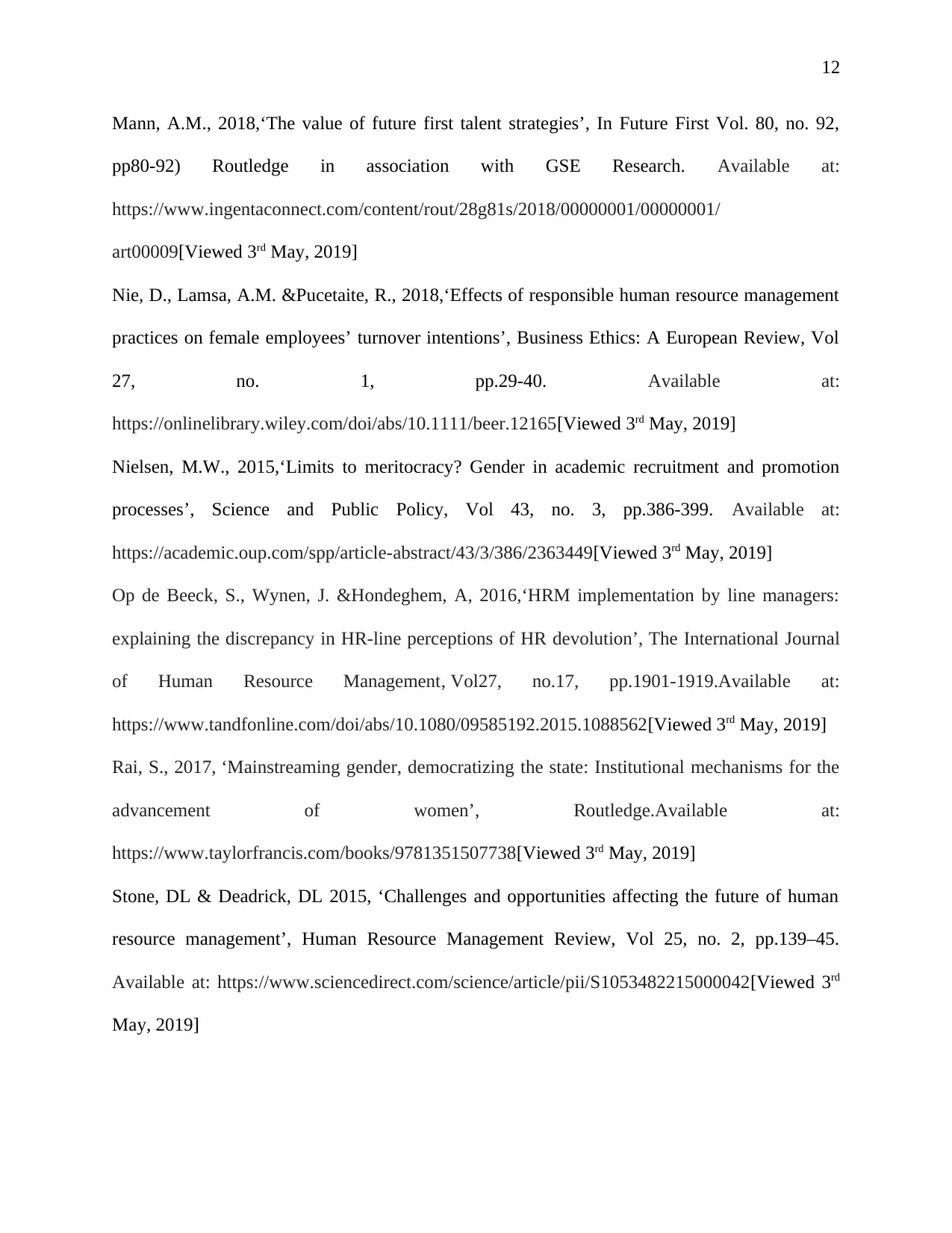
12
Mann, A.M., 2018,‘The value of future first talent strategies’, In Future First Vol. 80, no. 92,
pp80-92) Routledge in association with GSE Research. Available at:
https://www.ingentaconnect.com/content/rout/28g81s/2018/00000001/00000001/
art00009[Viewed 3rd May, 2019]
Nie, D., Lamsa, A.M. &Pucetaite, R., 2018,‘Effects of responsible human resource management
practices on female employees’ turnover intentions’, Business Ethics: A European Review, Vol
27, no. 1, pp.29-40. Available at:
https://onlinelibrary.wiley.com/doi/abs/10.1111/beer.12165[Viewed 3rd May, 2019]
Nielsen, M.W., 2015,‘Limits to meritocracy? Gender in academic recruitment and promotion
processes’, Science and Public Policy, Vol 43, no. 3, pp.386-399. Available at:
https://academic.oup.com/spp/article-abstract/43/3/386/2363449[Viewed 3rd May, 2019]
Op de Beeck, S., Wynen, J. &Hondeghem, A, 2016,‘HRM implementation by line managers:
explaining the discrepancy in HR-line perceptions of HR devolution’, The International Journal
of Human Resource Management, Vol27, no.17, pp.1901-1919.Available at:
https://www.tandfonline.com/doi/abs/10.1080/09585192.2015.1088562[Viewed 3rd May, 2019]
Rai, S., 2017, ‘Mainstreaming gender, democratizing the state: Institutional mechanisms for the
advancement of women’, Routledge.Available at:
https://www.taylorfrancis.com/books/9781351507738[Viewed 3rd May, 2019]
Stone, DL & Deadrick, DL 2015, ‘Challenges and opportunities affecting the future of human
resource management’, Human Resource Management Review, Vol 25, no. 2, pp.139–45.
Available at: https://www.sciencedirect.com/science/article/pii/S1053482215000042[Viewed 3rd
May, 2019]
Mann, A.M., 2018,‘The value of future first talent strategies’, In Future First Vol. 80, no. 92,
pp80-92) Routledge in association with GSE Research. Available at:
https://www.ingentaconnect.com/content/rout/28g81s/2018/00000001/00000001/
art00009[Viewed 3rd May, 2019]
Nie, D., Lamsa, A.M. &Pucetaite, R., 2018,‘Effects of responsible human resource management
practices on female employees’ turnover intentions’, Business Ethics: A European Review, Vol
27, no. 1, pp.29-40. Available at:
https://onlinelibrary.wiley.com/doi/abs/10.1111/beer.12165[Viewed 3rd May, 2019]
Nielsen, M.W., 2015,‘Limits to meritocracy? Gender in academic recruitment and promotion
processes’, Science and Public Policy, Vol 43, no. 3, pp.386-399. Available at:
https://academic.oup.com/spp/article-abstract/43/3/386/2363449[Viewed 3rd May, 2019]
Op de Beeck, S., Wynen, J. &Hondeghem, A, 2016,‘HRM implementation by line managers:
explaining the discrepancy in HR-line perceptions of HR devolution’, The International Journal
of Human Resource Management, Vol27, no.17, pp.1901-1919.Available at:
https://www.tandfonline.com/doi/abs/10.1080/09585192.2015.1088562[Viewed 3rd May, 2019]
Rai, S., 2017, ‘Mainstreaming gender, democratizing the state: Institutional mechanisms for the
advancement of women’, Routledge.Available at:
https://www.taylorfrancis.com/books/9781351507738[Viewed 3rd May, 2019]
Stone, DL & Deadrick, DL 2015, ‘Challenges and opportunities affecting the future of human
resource management’, Human Resource Management Review, Vol 25, no. 2, pp.139–45.
Available at: https://www.sciencedirect.com/science/article/pii/S1053482215000042[Viewed 3rd
May, 2019]
⊘ This is a preview!⊘
Do you want full access?
Subscribe today to unlock all pages.

Trusted by 1+ million students worldwide
1 out of 13
Related Documents
Your All-in-One AI-Powered Toolkit for Academic Success.
+13062052269
info@desklib.com
Available 24*7 on WhatsApp / Email
![[object Object]](/_next/static/media/star-bottom.7253800d.svg)
Unlock your academic potential
Copyright © 2020–2025 A2Z Services. All Rights Reserved. Developed and managed by ZUCOL.




